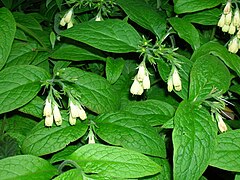| Habit | bulbous
| |
|---|---|---|
| Height: | ⇕ | 18 in"in" can not be assigned to a declared number type with value 18. to 24 in"in" can not be assigned to a declared number type with value 24. |
| Width: | ⇔ | 36 in"in" can not be assigned to a declared number type with value 36. to 40 in"in" can not be assigned to a declared number type with value 40. |
| Lifespan: | ⌛ | perennial |
| Bloom: | ❀ | early summer, mid summer, late summer |
| Exposure: | ☼ | sun |
|---|---|---|
| Features: | ✓ | flowers, birds |
| USDA Zones: | 5 to 10 | |
| Flower features: | ❀ | orange, yellow |
Symphytum tuberosum, the Tuberous Comfrey or in Gaelic Meacan Dubh Cnapach, is a species of Symphytum in the Boraginaceae family.
Tuberous Comfrey flowers from April to June, however it also reproduces asexually, that is vegetatively, having rhizomes that allow it to spread out from the original site, colonising and competing as it grows. This process continues into the autumn and the young clonal plants can be seen at this time of year, whilst the parent plants leaves are rotting down. Being very hardy, this plant is well able to survive northern winters. [1] Both the stems and leaves are softly hairy, the leaves have deep veining. [2]
The flowers themselves are a subtle pale creamy yellow, a significant characteristic for separating its identity from the purple flowered Russian Comfrey. The usual pollinators are the common carder bumble bee, honey bee, and red mason bee. The stem and leaves are clothed with soft hairs. The stem usually remains unbranched and the leaves are distinctly veined with a clear reduction in size from top to base.
Cultivation
Propagation
Pests and diseases
Varieties
Gallery
References
External links
- w:Symphytum tuberosum. Some of the material on this page may be from Wikipedia, under the Creative Commons license.
- Symphytum tuberosum QR Code (Size 50, 100, 200, 500)
